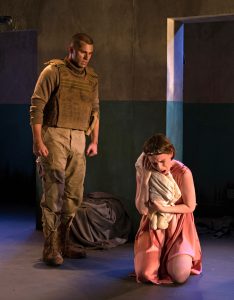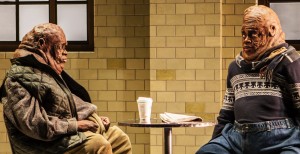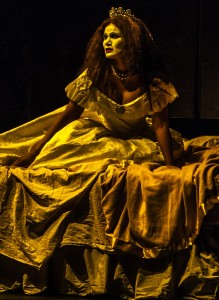A newsreel about faith-based adoption restrictions on Jewish, Muslim and interfaith couples in the state of Texas plays somberly over a smooth jazz gospel concert at the start of The Crusade of Connor Stephens, a new play by Dewey Moss. In between the voices of newsreaders decrying the discriminatory new laws and the gospel choir, an evangelist preacher calls for us to repent our sins and come into the light of the Lord Our God. It’s enough to make a New York audience gag.
Cracking Open
In Honor Molloy's Crackskull Row, a hovel in Dublin becomes the unlikely setting for an emotionally overwrought, Oedipal drama. The play is set in 1999, but it has the audience fooled—Molloy's play has all the trappings of a mid-20th-century, Joycean family narrative. Although the audience often hears references to staples of modern life—mobile phones, an ESB (Electricity Supply Board) company, even Oxfam—they sound anachronistic against this landscape of aged, mournful nostalgia. But for all its old-world charm, Molloy's riveting words don't translate perfectly to the stage. Directed by a courageous Kira Simring and staged by the cell at the Workshop Theatre, this beautifully written, hauntingly poetic story struggles to find the right tongues for its finely crafted words.
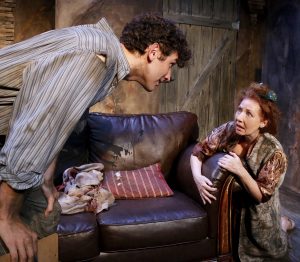
The production opens with the dour throb of a drum and that sprightly music so unique to the Irish musical tradition. An old man named Rasher/Basher, played by Colin Lane, enters, a lone figure with light streaming around him, and says that the sound we hear is "the thrum of the bodhran." It is a kind of Irish drum, well-known for its dooming, thumping sound. He talks wearily, anxiously, about his past, saying that his 'Da' was a musician, and that, although he's been away from home for 33 years, he's become the "spit and shite" of his father's likeness. A sense of foreboding takes hold, the rhythm of the bodhran notwithstanding. Then we see the ramshackle insides of a Dublin home. A vast, untidy sofa, wooden walls with peeling plaster, and a film of dirt covering the kitchen all clue us into the premise of Crackskull Row: a home has been leveled by the passage of time but seems ripe for renewed activity.
What follows is a disturbing but absorbing puzzle about Rasher Moorigan (John Charles McLaughlin), his father Basher (Lane, who also plays the older Rasher), mother Masher (Terry Donnelly) and daughter Dolly (Gina Costigan). Masher is almost literally rotting inside her electricity-less, plumbing-less home on Crackskull Row, her bills from the ESB piling up on the sofa. And while her past bothers her terribly, she is saved by the remembrance of her son, Rasher, and the sustenance of her daughter, Dolly. But it's soon apparent that the narrator, an aged Rasher, himself is unreliable, as are one's eyes and ears. Personae are fluid; the four players inhabit other bodies, take on different accents, and change their clothes easily. Suffice it to say that Rasher and Masher Moorigan are hiding a lethal, 30-year-old secret, the reverberations of which are still knocking around in their battered skulls.
There is much to admire about the production, including some fine performances from John Charles McLaughlin, who plays a young, on-edge, perversely romantic Rasher, and Gina Costigan, whose Dolly is a complex, willful thing. But their enthusiasm doesn't quite make up for the uneasy adaptation from script to stage. Crackskull Row often values dramatic potential over clarity, and while some climactic, intimate scenes (like Rasher's interactions with Dolly, or the dying moments of the play) are intensely dramatic, others fall into a spasmodic mode of meaningless activity. The result is not just an abrogation of Molloy's authorial intent for Crackskull Row, but a confusingly paced, occasionally overwrought performance.
Save for a few rare scenes of sparkling chemistry, the production threatens to come away at the seams. Molloy's dialogue is chock-full of intelligent wordplay, quick humor, and wit, but combined with the Irish brogue and quick delivery, her words (when delivered on stage) take a while to register. As a result, the enjoyment of the play is temporarily stunted. Much of the magic that can be read in Molloy's teasing, metaphorical writing is either difficult to find or nonexistent in the staging. We happen upon the wordplay, or a throwaway malapropism, a little too late to derive a complete appreciation of the story.
Yet, the production is redeemed and revived by its flowing, narrative core, and the actors who bring it to life. The chemistry between McLaughlin and Costigan is palpable; it's not for nothing that the Masher-Rasher relationship is central to the play. Lane brings a nostalgic weariness to his role, and lends a dreamy gravitas to the production. But it is Costigan who bears much of Molloy's light-hearted darkness from the page to the stage; she plays Dolly with riveting, minimalist understanding. Even her mirror, Terry Donnelly's Masher, does not waste a single movement (although words seem to be held in lower regard). To help us forget this latter discourtesy, M. Florian Staab (responsible for all the original music and sound design) punctuates scene changes with welcome percussion and fiddle-song. In moments of stillness or silence, there is Daniel Geggatt’s set to appreciate, in blue, brown and yellow, seeming for all intents and purposes like a living thing. As for the other living things taking the stage, they—and the playwright—are among the only reasons you should take a trip to the Workshop Theater this week.
The cell's production of Crackskull Row runs through Sept. 25. Evening performances are at 7 p.m. Thursday through Saturday; matinees are at 3 p.m. Saturday and Sunday. There are additional performances at 7 p.m. on Sept. 14 and 21. The Main Stage of the Workshop Theatre is at 312 West 36th St. (between Eighth and Ninth avenues). Tickets are $25. For more information about the show and tickets, visit www.thecelltheatre.org.
When Women Burn
The visual imagery presented in The Flea's The Trojan Women strikes two seemingly disparate chords upon viewing. One is of The Rape of the Sabine Women, an ancient Roman story about soldiers who arrived on the shores of Italy. The men abducted and otherwise ravished a group of Sabine women. Another image, more overt (and one we are asked to leave the theater with), is the violent uprooting of millions of Syrian refugees from their homes. As Hecuba, Helen, Andromache and Cassandra bitterly mourn their fallen city, we cannot help but think of their lives in a foreign, hostile country, as they are carried off in boats that are almost as precarious as their hollow futures.
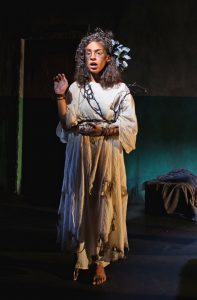
This resonance, sometimes obvious and sometimes thrillingly unspoken, is the beating heart of this drama, written by the silver-tongued Ellen McLaughlin. Enveloping this drama, which has survived well past its antiquarian origins, is the tragic, antediluvian helplessness of postwar women at the hands of their conquerors. It is the human tension of the play, with its mostly female cast, that rings through McLaughlin's words and lifts the story into beautiful, complex territories. Directed by Anne Cecelia Haney and under the much-lauded artistic directorship of Niegel Smith, this adaptation of Euripides' antebellum narrative, if occasionally flighty, is moving and cinematic in its scope.
The play begins with the drugged monotone of waves crashing against a beach, as we are welcomed into The Flea's downstairs theater. It seats perhaps forty—the intimacy of the space threatens our bubble of suspended disbelief. As if painted onto the wall, a turbaned, blindfolded woman sits, waiting. On the floor lie some six women—this is the Chorus—curled up and covered in grey blankets. The music of the sea gradually bestirs the blindfolded woman, and from her commanding voice and gait, we gather that she is Hecuba (played by a marvelous DeAnna Supplee), former queen of Troy and war prize for the Greeks. The women of Troy have been captured by their enemies the Greeks following the sack of Troy, and are waiting to be shipped off to kings' courts as slaves, concubines or second wives—harder luck perhaps than their Sabine ancestors. Cassandra (a powerful Lindsley Howard) and Andromache (Casey Wortmann, wonderful) are among the most haunted: the former has been 'made mad' by the god Apollo for spurning his love, and the latter is the widow of Hector, a fallen Trojan prince. All are violently helpless and burning with war trauma, with nothing to do but wait.
Haney has expertly interpreted McLaughlin's words, which retain most of the flair and poetry of Euripides' original. As the Trojan women dream of their future lives, they repeat stories of far off countries: "If you wash your hair in their rivers," one of them says, "they come out gold." Haney builds particular emphasis around this optimism, for it is mirrored in the current refugee crisis that has shaken the world with its sorrow. Here is where McLaughlin, who first adapted the story with the Bosnian war and its aftermath in mind, becomes fickle: the plot is held together by the barest of backbones, and for all the characters' elegies and monologues, there are times when the postwar narrative seems too forced, too distant. But when we are reminded, it is powerful: doctors, engineers and artists leave behind their burning cities for lives as taxi drivers, postmen and even unemployment, just as Hecuba, Andromache, and their once regal companions become less than their former selves. They resign themselves to lives of physical and emotional imprisonment.
Hecuba embodies all the nostalgia, mad sorrow and pride of her fallen Trojan citizens. Supplee delivers the fallen queen's lines with wounded ferocity; even when she whispers, there is weight and regality behind it. Tears shine perpetually in Hecuba's eyes—her only equal is Helen (Rebeca Rad), played with a great deal more pathos and wit than the original character is intended to have. In the 1971 film, starring the luminescent Vanessa Redgrave and Katharine Hepburn as Andromache and Hecuba respectively, Helen is a teasing, dangerous, one-dimensional male fantasy (both ancient playwright and seventies era director were male, after all). Rad anneals this fantasy with humanity; her lines are the most moving ones McLaughlin has written in the play.
The entrance of a male soldier, Talthybius (Phil Feldman) towards the end spins the play into a climax. Suffice it to say, he is dressed in combat gear and bears bad news for the women, just as they have seemingly reconciled themselves to their futures. In happier moments, the play has spontaneous moments of song and dance, welcome augmentations to the narrative. Lighting and sound design (Scot Gianelli and Ben Vigus respectively) are both characters of their own, booming and crackling with emotion as the play progresses. Both are also responsible for the cinematic sweep of the concluding scenes, perhaps some of the best minutes of The Trojan Women. Come for the nostalgia and the instructive, present performances, but stay for those dying moments.
The Trojan Women runs through Sept. 26. Performances are Thursday through Saturday at 9 p.m. and Sunday at 3 p.m. Tickets are $15-$20 with the lowest priced tickets available on a first-come, first-served basis. The Flea Theater is located at 41 White St. between Church St. and Broadway. Purchase tickets by calling 212-352-3101 or visit theflea.org.
Signature Moves
The Sandbox opens inside a blinding yellow set, and the audience oohs at the sight of a rippling male abdomen, belonging to that of a nameless Young Man standing on a beach, as he stretches his arms up and down. The first impression of this play, the opener in three one-acts under the umbrella title of “Signature Plays,” is that of visual and aural superfluity. In the remaining two plays, Drowning by María Irene Fornés and Funnyhouse of a Negro by Adrienne Kennedy, the visual impressions push and pull between deficit and excess. Albee, Kennedy and Fornés, all resident artists of Signature Theatre’s past seasons, are commemorated in this series of plays; with such heavyweights, it’s no surprise that empathy, satire, and metaphor figure beautifully in a production that fantastically sequenced and pleasingly produced.
In Edward Albee’s tragicomic The Sandbox, bright, gaudy beachwear dances on the bodies of the players, and a cellist plays an affecting, mournful solo throughout. Mommy (Alison Fraser) and Daddy (Frank Wood) are spending an aimless, empty day at the beach, and have dragged a particularly voluble Grandma (Phyllis Somerville) along. Grandma is nearing her end, and she is (ironically) very much taken by the Young Man (Ryan-James Hatanaka) flexing and stretching beside her. Hilarious fourth-wall breaks somewhat diminish the cello’s winding dirge (the music is by Brandon Wolcott), but age and the requisite humor of growing old suffuse Albee’s questions with sadness. The cake-like set (by Mimi Lien) is jarringly reminiscent of filmmaker Wes Anderson’s visual ideas; the striking environment serves as the backdrop for the writer’s melancholic humor. Under Houghton’s masterful direction, the actors are the visual realization of Albee’s kooky, world-weary amusement.
From this melancholic treat for the eyes and ears, we are steered into María Irene Fornés’ Drowning. If there was ever a play that was built to test the dramatic resolve of its audience, it is Drowning. Fornés’ one-act play takes place in what looks like a old-timey diner. The first visual shock we receive are the strange, melted get-ups that the two main characters, Pea (Mikeah Ernest Jennings) and Roe (Sahr Ngaujah), have on. They have science-fiction bodies, although Roe reassures Pea: “You are made of human flesh.” And for our next visual jolt: every movement the actors make is made with agonizing, breathtaking slowness. The push of a newspaper, a lean forward, even the blink of the eye, are retrograded and decelerated. Jennings and Ngaujah move through molasses, as their characters struggle to reconcile their inward innocence and hope with society's reactions to their ugliness.
In perhaps the highlight of the production, Fornés’ slow-moving masterpiece is rendered into a magical, morphing painting. Every visual element is a lullaby of movement. When Pea is rejected by a "fair" woman he has fallen for, Jennings electrifies his performance with anguish, breaking the slow, known rhythm of movement through molasses and yielding to a restive, frenzied unhappiness. His vocalizations of this unhappiness and particularly moving: he says that he is “too smooth and black” for this world, too ugly, undesirable and rough to validate his claim for a fair woman's love. It is difficult to ignore, as is Fornés’ intention, the sharp allegorical reference to the modern plight of the young black man. How does he deal with society's rejection of him, a rejection so inherently based on the color of his skin? Does he ignore the tension bubbling inside of him, as Ngaujah’s Roe does, or does he have no choice but to exorcise it by speaking aloud, as the unfortunate Pea endeavors to?
But if Drowning was a statement on the modern condition of the young black man, Adrienne Kennedy’s Funnyhouse of a Negro is the ultimate homage to the modern mixed life of a half-black, half-white woman. As the final piece in the production, Funnyhouse’s undeterred commitment to shock, upset and amaze its viewers proved an almighty boon to Kennedy's terrific play. From direction (Houghton) to brilliant costume and sound design (Kaye Voyce and Wolcott, respectively), Funnyhouse was the standout piece of the night. It follows the elegantly cosmopolitan mind of the author, studying English literature in New York and living in anonymity, yet struggling with the emotional trauma of her family’s past. On stage, the author (played by Crystal Dickinson) guides us through her varied relationships with Patrice Lumumba, her father and a troubled African priest (a fantastic Sahr Ngaujah), Jesus, and her gold-clad avatars, including the white-faced Duchess of Hapsburg. Booms and swells of jolting, terrifying music punctuate Kennedy’s allegories. Each actor inflects his lines with the playwright’s unique poetic intent—that her emotional life has the makings of a nightmare. It is full of sound, fury and the inescapable divisiveness of growing up as black and a white woman.
Scenic designer Lien again creates a resplendent set, full of moving staircases, disappearing mirrors and golden chandeliers. Red draperies hang from a gilded bed, and pockets of light shine suggestively in corners. The beauty of the final play reminds us strikingly of that bright yellow scene from The Sandbox, and the dancer-like finesse of Drowning. Director James Houghton has seemingly bound the threads of three disparate tales into a single, heady production. Aside from the welcome challenge of building one’s visual literacy as a theatergoer, eyes and ears will take infinite delight in the impressionistic treats of the “Signature Plays.”
“Signature Plays” runs through June 12 in The Alice Griffin Jewel Box Theatre at The Pershing Square Signature Center (480 West 42ndSt.,between 9th and 10th Avenues). For dates and box office information, please visit http://www.signaturetheatre.org//tickets/production.aspx?pid=4284









